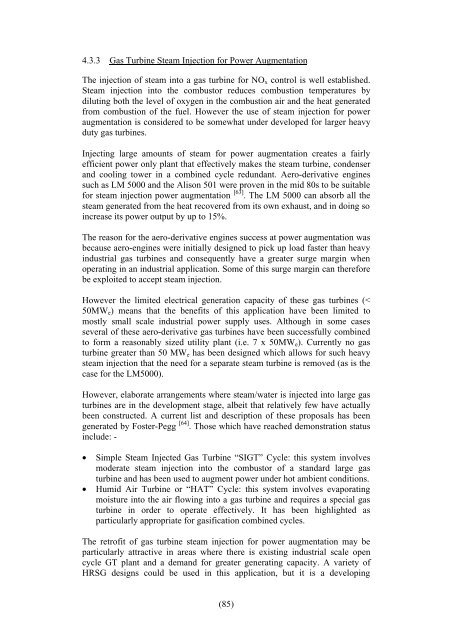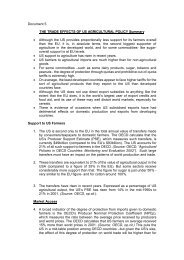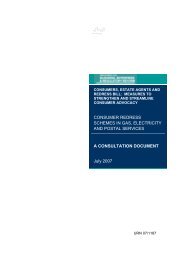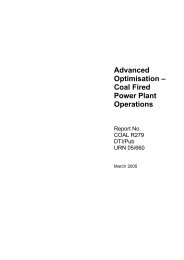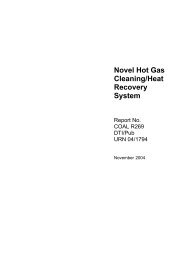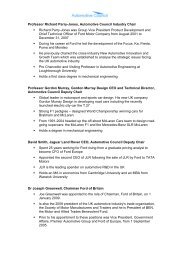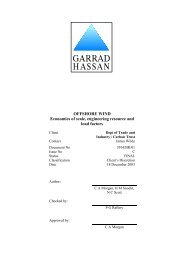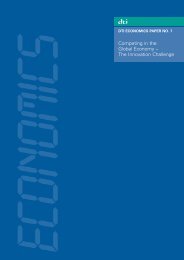(70) Therefore, the risk of sulphuric acid dew point attack ... - DTI Home
(70) Therefore, the risk of sulphuric acid dew point attack ... - DTI Home
(70) Therefore, the risk of sulphuric acid dew point attack ... - DTI Home
Create successful ePaper yourself
Turn your PDF publications into a flip-book with our unique Google optimized e-Paper software.
4.3.3 Gas Turbine Steam Injection for Power Augmentation<br />
The injection <strong>of</strong> steam into a gas turbine for NOx control is well established.<br />
Steam injection into <strong>the</strong> combustor reduces combustion temperatures by<br />
diluting both <strong>the</strong> level <strong>of</strong> oxygen in <strong>the</strong> combustion air and <strong>the</strong> heat generated<br />
from combustion <strong>of</strong> <strong>the</strong> fuel. However <strong>the</strong> use <strong>of</strong> steam injection for power<br />
augmentation is considered to be somewhat under developed for larger heavy<br />
duty gas turbines.<br />
Injecting large amounts <strong>of</strong> steam for power augmentation creates a fairly<br />
efficient power only plant that effectively makes <strong>the</strong> steam turbine, condenser<br />
and cooling tower in a combined cycle redundant. Aero-derivative engines<br />
such as LM 5000 and <strong>the</strong> Alison 501 were proven in <strong>the</strong> mid 80s to be suitable<br />
for steam injection power augmentation [63] . The LM 5000 can absorb all <strong>the</strong><br />
steam generated from <strong>the</strong> heat recovered from its own exhaust, and in doing so<br />
increase its power output by up to 15%.<br />
The reason for <strong>the</strong> aero-derivative engines success at power augmentation was<br />
because aero-engines were initially designed to pick up load faster than heavy<br />
industrial gas turbines and consequently have a greater surge margin when<br />
operating in an industrial application. Some <strong>of</strong> this surge margin can <strong>the</strong>refore<br />
be exploited to accept steam injection.<br />
However <strong>the</strong> limited electrical generation capacity <strong>of</strong> <strong>the</strong>se gas turbines (<<br />
50MWe) means that <strong>the</strong> benefits <strong>of</strong> this application have been limited to<br />
mostly small scale industrial power supply uses. Although in some cases<br />
several <strong>of</strong> <strong>the</strong>se aero-derivative gas turbines have been successfully combined<br />
to form a reasonably sized utility plant (i.e. 7 x 50MWe). Currently no gas<br />
turbine greater than 50 MWe has been designed which allows for such heavy<br />
steam injection that <strong>the</strong> need for a separate steam turbine is removed (as is <strong>the</strong><br />
case for <strong>the</strong> LM5000).<br />
However, elaborate arrangements where steam/water is injected into large gas<br />
turbines are in <strong>the</strong> development stage, albeit that relatively few have actually<br />
been constructed. A current list and description <strong>of</strong> <strong>the</strong>se proposals has been<br />
generated by Foster-Pegg [64] . Those which have reached demonstration status<br />
include: -<br />
• Simple Steam Injected Gas Turbine “SIGT” Cycle: this system involves<br />
moderate steam injection into <strong>the</strong> combustor <strong>of</strong> a standard large gas<br />
turbine and has been used to augment power under hot ambient conditions.<br />
• Humid Air Turbine or “HAT” Cycle: this system involves evaporating<br />
moisture into <strong>the</strong> air flowing into a gas turbine and requires a special gas<br />
turbine in order to operate effectively. It has been highlighted as<br />
particularly appropriate for gasification combined cycles.<br />
The retr<strong>of</strong>it <strong>of</strong> gas turbine steam injection for power augmentation may be<br />
particularly attractive in areas where <strong>the</strong>re is existing industrial scale open<br />
cycle GT plant and a demand for greater generating capacity. A variety <strong>of</strong><br />
HRSG designs could be used in this application, but it is a developing<br />
(85)


